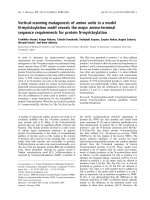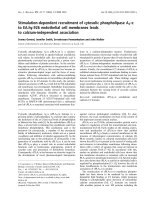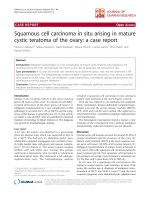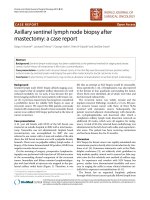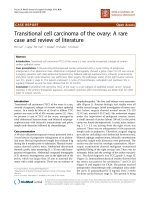báo cáo khoa học: "Squamous cell carcinoma of rectum presenting in a man: a case report" potx
Bạn đang xem bản rút gọn của tài liệu. Xem và tải ngay bản đầy đủ của tài liệu tại đây (433.01 KB, 6 trang )
CAS E REP O R T Open Access
Squamous cell carcinoma of rectum presenting in
a man: a case report
A Syed Sameer
1,2,3
, Nidda Syeed
1
, Nissar A Chowdri
3
, Fazl Q Parray
3
, Mushtaq A Siddiqi
1*
Abstract
Background: Primary squamous cell carcinomas of the colorectum are very uncommon. Until now, to the best of
our knowledge, only 114 cases of squamous cell carcinoma in the colorectum exist in the reported literature. Here
we report a case of squamous cell carcinoma of the rectum in the ethnic Kashmiri population in northern India.
Case Presentation: The case of a 60-year-old male patient (Asian) with a pure squamous cell carcinoma of the
rectum is presented here. The patient underwent a curative surgery with concomitant chemotherapy. Two years
after the initial curative resection of the tumor he is still alive.
Conclusion: The prognosis for squamous cell carcinoma of the colorectum is worse than for that of
adenocarcinoma, because of the delayed diagnosis. The etiopathogenicity of squamous cell carcinoma of the
colorectum is discussed. Surgical resection of the lesion seems to be the treatment of choice. Chemotherapy also
helps in improvement of the prognosis.
Introduction
The occurrence of squamous cell carcinomas (SCC) in
the colorectum is a rare entity representing a small frac-
tion of colorectal malignancies, since more than 90% of
colorectal diseases are adenocarcinoid tumors [1]. Very
little information is available in the literature about the
etiology, prognosis and optimal treatment of this malig-
nancy [2]. Here in this study, we describe a patient with
SCC of the rectum who underwent a lower anterior
resection (LAR) for the possible treatment of the
malignancy.
Case presentation
A 60-year-old male patient from an urban area of Kash-
mir (Asian) visited the Department of Gen eral Medicine
of our institute with the chief complaints of severe
lower-abdominal pain for the past eight months. The
patient also complained of severe constipation, nausea,
vomiting, anorexia, loss of appetite, abdominal cramps,
incontinence of faeces and weight loss during the past
four months. He experienced profuse bleeding from the
rectum for the last month. Initial interviews with the
patient revealed that the he was a heavy smoker and fre-
quent user of noon-chai (Salt tea), meat and pickles. On
examination the patient was fo und to be anemic. Digital
rectal examination revealed an ulcero-infiltrative lesion
with restricted mobility about 4 cm from the anal verge
on the left lateral wall. A colonoscopy confirmed the
rectal examination and biops ies taken at the time of the
colonoscopy revealed squamous cell carcinoma (SCC) of
basal cell type in the first histopathological examination.
The report was re-confirmed by a second independent
pathologist. A Contrast-Enhanced Computed Tomogra-
phy (CECT) of the chest, abdomen and pelvis was also
done but n o lesions were found in any other site than
the rectum. The lesion was without any fat stranding or
lymphadenopathy. Furthermore, following the provi-
sional diagnosis, the patient was referred to the Depart-
ment of General Surgery for radical treatment, where he
underwent LAR of the rectum using the standard tech-
nique of mesorectal excision (Figure 1). The continuity
of the gu t was restored by a circular stapler for low col-
orectal anastomosis with formation of a colonic p ouch.
The colonic pouch takes over the function of rectal
reservoir which is lost after excision of the middle and
lower rectum. Microscopic examination of the resected
lesion demonstrated a 2.5 cm × 3 cm SCC tumor of the
rectum infiltrating the serosa. The margins of the
* Correspondence:
1
Department of Immunology and Molecular Medicine, Sher-I-Kashmir
Institute of Medical Sciences, Soura, Srinagar, Kashmir, 90011, India
Full list of author information is available at the end of the article
Sameer et al. Journal of Medical Case Reports 2010, 4:392
/>JOURNAL OF MEDICAL
CASE REPORTS
© 2010 Sameer et al; licensee BioMed C entral Ltd. This is an Open Access article distributed under the terms of the Creative Commons
Attribution License ( which permits unrestricted use, di stribution, and rep rodu ction in
any medium, provid ed the original work i s properly cited.
excised tissue were found to be free of the tumor. How-
ever, four regional lymph nodes were also infiltrated by
the metastatic SCC cells. The liver and the rest of the
organs were free of a ny metastasis. The slides were
reviewed by a third histopathologist who reported the
lesion as poorly different iated squamous cell carcinoma.
The stage of the tumor was found to be T
3
N
2
M
o
.The
post-operative period was uneventful. Post-operatively
the patient received four cycles of chemotherapy with
cisplastin and 5-fluorouracil for five days. The patient is
on two years of follow-up and has not shown any evi-
dence of recurrenceas of the present time.
Discussion
Colorectal cancer (CRC) is the third most common
cause of c ancer-related death in the world [3]. Almost
90% of CRC are adenocarcinomas, while the remaining
10% are made up of carcinomas, sarcomas and lymphoid
tumors [1]. The occurrence of SCC in the gastrointest-
inal tract (GIT) is a rare phen omenon, and its occu r-
rence in the colorectum is extremely unusual [4]. The
incidence of SCC of the colorectum has been reported
to be almost 0.1 to 0.25 per 1000 CRC [4,5]. A look into
the research work and the reported cases of SCC dates
back to 1907, when Herxheimer reported adenosqua-
mous carcinoma of the cecum but it was in 1919 when
the first case of pure SCC of the colon was reported by
Schmidtmann [6] in a 65-year-old man [7]. I t was not
until 1933 that the first case involving the rectum was
subsequently described by Raiford [8]. In India, Bhat
et al.[9]reportedthefirstcaseofpureSCCofthe
colon in 1993 in a 55-year-old female from the southern
part of the country. Until now a lmost 120 cases of SCC
have been reported from all over the world (See Table 1).
Surprisingly, a study from Russia reported 107 cases of
SCC from a single center alone [10] but there has been
no such reports of high incidence of SCC in the colorec-
tum from any other part of the world.
Before the diagnosis of primary SCC of colorectum is
made, certain criteria must be fulfilled as given by Wil-
liams et al.in1979[11].Thiscriteriaincludes:(A)
absence of evidence of squa mous cell carcinoma of any
other part of the body, ruling out any chance of possible
metastasis from any organ to the colorectal site; (B)
exclusion of any proximal extension of anal squamous
cell carcinoma; (C) absence of fistulous tract lined by
squamous cells; and (D) confirmation of SCC by histolo-
gical analysis [1,4,12]. All of these criteria were fulfilled
by our case.
A look at the available literature reveals that squa-
mous cell carcinoma of the colorectum affects indivi-
duals with a mean age of 55 to 60 years Women are
more frequently predisposed to SCC than men, around
66% of cases occurred in women and 34% in men.
Furthermore, SCC occurs in conco mitance with an
advanced tumor stage (Duke’s C) [4,13]. Since SCC of
the rectum is a rare tumor, epidemiological data consti-
tuting patient demographics, risk factors and natural
history are lacking in the literature. The clinical charac-
teristics of the patients with SCC of the colorectum are
similar to t hose with adenocarcinoma: rectal bleeding,
abdominal pain, change in bowel habits and weight loss
[4]. Because of the rare nature of this malignancy the
prognosis for patients is difficult to establish, Comer et
al. suggested a poorer prognosis for patients with color-
ectal SCC than adenocarcinoma [1,4,14].
Almost four different pathophysiological theories
regarding the origin of squamous cell carcinoma of the
colorectum have been proposed in the literature so far.
These can be summarized as: (A) Proliferation of
uncommitted basal cells in to squamous cells which
undergo malignant transformation following mucosal
injury [15]; (B) Ability of pluripo tent stem cells to
undergo spont aneous squamous differentiation [16]; (C)
Squamous metaplasia of glandular epithelium resulting
from chronic inflammation or irritation, secondary to
inflammatory bowel dis ease [17], infection [18] or radia-
tion [19]; (D) Origin from embryonal nests of ectoder-
mal cells; and (E) Arousal of carcinomas from
preexisting adenomas or adenocarcinomas [7,20].
Conclusion
In conclusion, advanced colorectal SCC has a poor
prognosis. Since colorectal SCC is a very rare disease,
treatment selection is difficult. However, surgical resec-
tion and adjuvant chemotherapy [21] is a better
approach to the treatment of colorectal SCC.
Consent
Written informed consent was obtained from the patient
for publication of this case report and accompanying
images. A copy of the written consent i s available with
Figure 1 Image showing the inner lining of the colon with a
rosette-shaped malignant tumor at the lateral wall of the
rectum.
Sameer et al. Journal of Medical Case Reports 2010, 4:392
/>Page 2 of 6
Table 1 Reported cases of squamous cell carcinoma of the colorectum (Data available from 1933 to 2009)
Study number Study Age Sex Surgery Outcome
01. Schmidtmann (1919) [6] 65 M NA Died after 1 m
02. Raiford (1933) [8] 43 F NA Died after 7 m
03. Catell et al. (1943) [22] 63 M LAR Alive at 3.5 y
04. Wiener et al. (1962) [23] 52 F APR Died at 1 y
05. Larizaden and Powell (1965) [24] 44 F APR Died at 1 y
06. Cabrera et al. (1967) [25] 62 F APR NR
50 F NR
07. Minkowitz et al. (1967) [26] 49 F Proctocolectomy Died after 5 m
08. Gaston et al. (1967) [27] 65 M Hemicolectomy Alive at 2 y
09. Pemberton and Lendrum (1968) [28] 48 F Hemicolectomy Alive at 2 y
10. Birnbaum et al. (1970) [29] 82 M Hemicolectomy NR
11. Corner et al. (1971) [14] 34 F APR Alive at 13 y
12. Lewis et al. (1971) [30] 61 M Hemicolectomy Died after 10 d
13. Balfour (1972) [31] 63 M NA Died after 18 m
14. Horne and McCulloch (1978) [32] 53 M Hemicolectomy Died after 11 m
15. Crissmann (1978) [33] 72 M Colectomy Died after 3 d
16. Burgess et al. (1979) [34] 43 M Hemicolectomy Died after 11 m
17. Williams et al. (1979) [11] 45 M APR Died after 9 m
18. Lasser et al. (1980) [35] 65 F N/A Alive at 3 y
48 F N/A Alive 8 m
54 M N/A Alive 17 m
19. Hickey and Corson (1981) [36] 48 F Hemicolectomy Alive at 21 m
20. Petrelli et al. (1981) [37] 73 M Colectomy Died after 9 d
21. Pitella and Torres (1982) [38] 33 M Ileocolic bypass Died after 10 d
22. Hey and Brandt (1982) [39] NA NA NA NA
NA NA NA NA
23. Lyttle et al. (1983) [40] 65 F Hemicolectomy Alive at 2 m
24. Vezeridis et al. (1983) [41] 56 M APR Died after 10 m
44 M APR Died after 9 d
61 F Died after 4 m
66 F Died after 15 m
62 F APR Died after 13 m
25. Gould et al. (1983) [42] 61 M Ileocolic bypass Died after 3 m
26. Francioni et al. (1983) [43] NA NA NA NA
27. Forouhar et al. (1984) [44] NA NA NA NA
28. Lafreniere et al. (1985) [13] 60 M TAE Alive at 2 y
29. Balsano et al. (1985) [45] 65 M Hemicolectomy NA
58 M Hemicolectomy NA
30. Chulia et al. (1986) [46] NA NA NA NA
31. Weidner and Zekan, (1986) [47] 73 M NA Died after 4 y
32. Piggott and Williams (1987) [48] 60 F APR Alive at 13 m
33. Woods et al. (1987) [49] 57 F APR Died after 3 m
34. Shao et al. (1987) [50] NA NA NA NA
35. Prener et al. (1988) [51] 43 F APR Died after 1 y
77 F Polypectomy Died after 3 y
55 F APR Alive at 3 y
55 M APR Died after 3 m
53 M APR Died after 1 y
Sameer et al. Journal of Medical Case Reports 2010, 4:392
/>Page 3 of 6
Table 1 Reported cases of squamous cell carcinoma of the colorectum (Data available from 1933 to 2009) (Continued)
36. Lundquest et al. (1988) [52] NA NA NA NA
37. Wyatt (1991) [53] 71 M NA Alive at 1 y
38. Schneider et al. (1992) [54] 44 M NA
69 F TAE Alive at 3 y
39. Betancourt et al. (1992) [55] NA NA NA NA
40. Vignale et al. (1993) [56] 69 M NA NA
41. Yoshida et al. (1994) [57] 51 M Hemicolectomy Died after 39 d
42. Vraux et al. (1994) [58] NA NA Chemotherapy Died after 5 y
43. Alekseev et al. (1994) [59] NA NA NA NA
44. Petrelli et al. (1996) [60] 62 M APR NA
41 F Colectomy NA
45. Martinez-Gonzalez et al. (1996) [61] 40 M LAR Alive at 18 m
46. Juturi et al. (1998) [62] 61 F Hemicolectomy Alive at 18 y
61 M Hemicolectomy Died after 15 m
47. Kim et al. (2001) [63] 41 F LAR Died after 4 m
48. Copur et al. (2001) [64] 54 M APR+CT NA
49. Sotlar et al. (2001) [65] 87 M LAR Died after 20 m
50. Frizelle et al. (2001) [66] 9 cases
51. Gelas et al. (2002) [2] 47 F APR+CT Alive at 16 y
63 M APR+CT Died after 14 m
70 F APR Died after 18 m
93 M Died after 4 m
45 F LAR Alive at 6 m
43 F LAR Alive at 2 y
52. Bhat et al. (2003) [9] 55 F Hemicolectomy NA
53 Kim, 2005 [67] 71 M NA
54. Anagnostopoulos et al. (2005) [7] 75 M APR Alive at 14 m
55. Lam et al. (2006) [68] 44 F LAR NA
56. Theodosopoulos et al. (2006) [21] 39 F APR Alive at 18 m
57. Ambrosini-Spaltro et al. (2006) [69] 81 M Hemicolectomy Alive at 2 y
58. Pikarsky et al. (2006) [70] 57 F Alive at 7 yr
59. Nahas et al. (2007) [5] 58 F10/M2 Alive at 2.6 yr
60. Miyamoto (2007) [1] 89 M Colectomy Died after 3 m
61. Cheng et al. (2007) [71] 51 F Proctocolectomy NA
62. Kong et al. (2007) [72] 48 F TAE Alive at 3 y
53 F NA
63. Clark et al. (2008) [73] 75 M Alive at 20 m
71 F Alive at 31 m
42 F Alive at 13 m
70 M Alive at 14 m
55 F LAR Alive at 19 m
45 F Alive at 23 m
71 F Alive at 5 m
Sameer et al. Journal of Medical Case Reports 2010, 4:392
/>Page 4 of 6
the corresponding author of this manuscript and is
accessible for review by the Editor-in-Chief of this
journal
Acknowledgements
The authors gratefully acknowledge the Sher-I-Kashmir Institute of Medical
Sciences, Kashmir for providing funds for this research work. The authors
also gratefully acknowledge the technical staff, especially Miss Roohi and Mr.
Reyaz of the Department of General Surgery for helping in the procurement
of tumor tissue samples from the Operation Theater. We also thank the
anonymous pathologists of the Department of Pathology for the
histopathological assessment of the tumor tissues.
Author details
1
Department of Immunology and Molecular Medicine, Sher-I-Kashmir
Institute of Medical Sciences, Soura, Srinagar, Kashmir, 90011, India.
2
Department of Clinical Biochemistry, Sher-I-Kashmir Institute of Medical
Sciences, Soura, Srinagar, Kashmir, 190011, India.
3
Department of General
Surgery, Sher-I-Kashmir Institute of Medical Sciences, Soura, Srinagar, Kashmir,
190011, India.
Authors’ contributions
ASS conceived and designed the study and wrote the manuscript. NS
suggested the necessary changes and copyedited the manuscript. NAC and
FQP procured and provided the tumor samples for the study. MAS
coordinated the study and revised the manuscript. All authors read and
approved the final manuscript.
Competing interests
The authors declare that they have no competing interests.
Received: 8 December 2009 Accepted: 30 November 2010
Published: 30 November 2010
References
1. Miyamotoa H, Nishiokaa M, Kuritaa N, Hondaa J, Yoshikawaa K,
Higashijimaa J, Miyatania T, Bandoub Y, Shimadaa M: Squamous cell
carcinoma of the descending colon: report of a case and literature
review. Case Rep Gastroenterol 2007, 1:77-83.
2. Gelas T, Peyrat P, Francois Y, Gerard JP, Baulieux J, Gilly FN, Vignal J,
Glehen O: Primary squamous-cell carcinoma of the rectum: report of six
cases and review of the literature. Dis Colon Rectum 2002, 45:1535-1540.
3. Sameer AS, Rehman S, Pandith AA, Syeed N, Shah ZA, Chowdhri NA,
Wani KA, Siddiqi MA: Molecular gate keepers succumb to gene
aberrations in colorectal cancer in Kashmiri population, revealing a high
incidence area. Saudi J Gastroenterol 2009, 15:244-252.
4. Dyson T, Draganov PV: Squamous cell cancer of the rectum. World J
Gastroenterol 2009, 15:4380-4386.
5. Nahas CS, Shia J, Joseph R, Schrag D, Minsky BD, Weiser MR, Guillem JG,
Paty PB, Klimstra DS, Tang LH, Wong WD, Temple LK: Squamous-cell
carcinoma of the rectum: a rare but curable tumor. Dis Colon Rectum
2007, 50:1393-1400.
6. Schmidtmann M: Zur Kenntnis seltener Krebsformen. Virchow Arch (A)
1919, 226:100-118.
7. Anagnostopoulos G, Sakorafas GH, Kostopoulos P, Grigoriadis K, Pavlakis G,
Margantinis G, Vugiouklakis D, Arvanitidis D: Squamous cell carcinoma of
the rectum: a case report and review of the literature. Eur J Cancer Care
Engl 2005, 14:70-74.
8. Raiford TS: Epitheliomata of the lower rectum and anus. Surg Gynecol
Obstet 1933, 57:21-35.
9. Bhat S, Pai M, Premnath RP: Primary squamous cell carcinoma of caecum.
Indian J Cancer 2003, 40:118-119.
10. Mel’nikov RA, Goshchitskiĭ LG, Kovalev VK: Clinical manifestations of
squamous cell carcinoma of the rectum. Vopr Onkol 1984, 30:76-83.
11. Williams GT, Blackshaw AJ, Morson BC: Squamous carcinoma of the
colorectum and its genesis. J Pathol 1979, 129:139-147.
12. Carroll D, Rajesh PB: Colonic metastases from primary squamous cell
carcinoma of the lung. Eur J Cardiothorac Surg 2001, 19:719-720.
13. Lafreniere R, Ketcham AS: Primary squamous carcinoma of the rectum.
Report of a case and review of the literature. Dis Colon Rectum 1985,
28:967-972.
14. Comer TP, Beahrs OH, Dockerty MB: Primary squamous cell carcinoma
and adenoacanthoma of the colon. Cancer 1971, 58:111-117.
15. Michelassi F, Montag AG, Block GE: Adenosquamous-cell carcinoma in
ulcerative colitis. Report of a case. Dis Colon Rectum. 1988, 31:323-326.
16. Ouban A, Nawab RA, Coppola D: Diagnostic and pathogenetic
implications of colorectal carcinomas with multidirectional
differentiation: a report of 4 cases. Clin Colorectal Cancer 2002, 1:243-248.
17. Fu K, Tsujinaka Y, Hamahata Y, Matsuo K, Tsutsumi O: Squamous
metaplasia of the rectum associated with ulcerative colitis diagnosed
using narrow-band imaging. Endoscopy 2008, 40:E45-E46.
18. Audeau A, Han HW, Johnston MJ, Whitehead MW, Frizelle FA: Does human
papilloma virus have a role in squamous cell carcinoma of the colon
and upper rectum? Eur J Surg Oncol 2002, 28:657-660.
19. Yurdakul G, de Reijke TM, Blank LE, Rauws EA: Rectal squamous cell
carcinoma 11 years after brachytherapy for carcinoma of the prostate. J
Urol 2003, 169:280.
20. Jaworski RC, Biankin SA, Baird PJ: Squamous cell carcinoma in situ arising
in inflammatory cloacogenic polyps: report of two cases with PCR
analysis for HPV DNA. Pathology 2001, 33:312-314.
21. Theodosopoulos TK, Marinis AD, Dafnios NA, Vassiliou JG, Samanides LD,
Carvounis EE, Smyrniotis VE: Aggressive treatment of metastatic
squamous cell carcinoma of the rectum to the liver: a case report and a
brief review of the literature. World Journal of Surgical Oncology 2006, 4:49.
22. Catell RB, Williams AG: Epidermoid carcinoma of the anus and rectum.
Arch Surg 1943, 46:336-349.
23. Wiener MF, Polayes SH, Yidi R: Squamous carcinoma with schistosomiasis
of the colon. Am J Gastroent 1962, 37:48-54.
24. Larizaden R, Powell DE: Neoplastic change in a duplicated colon. Br J Surg
1965, 52:666-668.
25. Cabrera A, Pickren JW: Squamous metaplasia and squamous-cell
carcinoma of the rectosigmoid. Dis Colon Rectum 1967, 10:288-297.
26. Minkowitz S: Primary squamous cell carcinoma of the rectosigmoid
portion of the colon. Arch Pathol 1967, 84:77-80.
27. Gaston EA: Squamous-cell carcinoma of the colon and rectum: report of
a case. Dis Colon Rectum 1967, 10:435-434.
28. Pemberton M, Lendrum J: Squamous-cell carcinoma of the caecum
following ovarian adenocarcinoma. Br J Surg 1968, 55:273-276.
29. Birnbaum W: Squamous cell carcinoma and adenoacanthoma of the
colon. JAMA 1970, 212:1511-1513.
Table 1 Reported cases of squamous cell carcinoma of the colorectum (Data available from 1933 to 2009) (Continued)
64. Rasheed et al. (2009) [74] 55 F Alive at 11 y
50 M Alive at 7 y
69 F Alive at 4 y
61 M APR Alive at 4 y
58 M APR Alive at 2 y
41 F Alive at 2 y
65. Our Case 60 M LAR Alive at 15 m
NA: not available; F: female; M: male; LAR: low anterior resection; APR: abdominoperineal resection; TAE:transanal excision; y: years; m: months and d: days
Sameer et al. Journal of Medical Case Reports 2010, 4:392
/>Page 5 of 6
30. Lewis PL, Harrer WV, Sencindiver PV: Primary squamous-cell carcinoma of
the cecum: report of a case. Dis Colon Rectum 1971, 14:213-217.
31. Balfour TW: Does squamous carcinoma of the colon exist? Br J Surg 1972,
59:410-412.
32. Horne BD, McCulloch CF: Squamous cell carcinoma of the cecum: a case
report. Cancer 1978, 42:1879-1882.
33. Crissman JD: Adenosquamous and squamous cell carcinoma of the
colon. Am J Surg Pathol 1978, 2:47-54.
34. Burgess PA, Lupton EW, Talbot IC: Squamous-cell carcinoma of the
proximal colon: report of a case and review of the literature. Dis Colon
Rectum 1979, 22:241244.
35. Lasser P, Elias D, Eschwege F: A propos de 3 cas d’epitheliomas
epidermoides du rectum. J Chir 1980, 117:377-380.
36. Hickey WF, Corson JM: Squamous cell carcinoma arising in a duplication
of the colon: case report and literature review of squamous cell
carcinoma of the colon and of malignancy complicating colonic
duplication. Cancer 1981, 47:602-609.
37. Petrelli M, Tetangco E, Reid JD: Carcinoma of the colon with
undifferentiated, carcinoid, and squamous cell features. Am J Clin Pathol
1981, 75:581-584.
38. Pittella JE, Torres AV: : Primary squamous-cell carcinoma of the cecum
and ascending colon: report of a case and review of the literature. Dis
Colon Rectum 1982, 25:483-487.
39. Hey A, Brandt G: [A pure squamous cell carcinoma of the large intestine.
Report of 3 personal observations and a literature review]. Pathologe
1982, 3:359-364.
40. Lyttle JA: Primary squamous carcinoma of the proximal large bowel.
Report of a case and review of the literature. Dis Colon Rectum 1983,
26:279-282.
41. Vezeridis MP, Herrera LO, Lopez GE, Ledesma EJ, Mittleman A: Squamous-
cell carcinoma of the colon and rectum. Dis Colon Rectum 1983,
26:188-191.
42. Gould L, Shah JM, Khedekar RR, Burns WA: Squamous cell carcinoma of
the splenic flexure of the colon. Dig Dis Sci 1983, 28:918-922.
43. Francioni G, Canuti S, Cardelli A, Montesi M: [Epidermoid carcinoma of the
colon. Clinical case of double recto-sigmoid basalioma]. Minerva Dietol
Gastroenterol 1983, 29
:33-38.
44. Forouhar F: Neoplastic colonic polyp with extensive squamous
metaplasia. Case report. Tumori 1984, 70:99-103.
45. Balsano NA: Squamous cell carcinoma of the cecum. Arch Surg 1985,
120:1176-1177.
46. Chulia F, Camps C, Rodriguez A, Medina E, Tuset J: Epidermoid carcinoma
of the colon. Description of a lesion located in the hepatic flexure. Dis
Colon Rectum 1986, 29:665-667.
47. Weidner N, Zekan P: Carcinosarcoma of the colon - Report of a unique
case with light and immuoistochemical studies. Cancer 1986,
58:1126-1130.
48. Piggott JP, Williams GB: Primary squamous cell carcinoma of the
colorectum: case report and literature review of a rare entity. J Surg
Oncol 1987, 35:117-119.
49. Woods WG: Squamous cell carcinoma of the rectum arising in an area of
squamous metaplasia. Eur J Surg Oncol 1987, 13:455-458.
50. Shao YF, Pan GL, Zhou CN, Yu HT: : [Squamous cell carcinoma of the
ascending colon–a case report and review of literature]. Zhonghua
Zhong Liu Za Zhi 1987, 9:315-316.
51. Prener A, Nielsen K: Primary squamous cell carcinoma of the rectum in
Denmark. APMIS 1988, 96:839-844.
52. Lundquest DE, Marcus JN, Thorson AG, Massop D: : Primary squamous cell
carcinoma of the colon arising in a villous adenoma. Hum Pathol 1988,
19:362-364.
53. Wyatt MG, Clarke TJ, Teasdale C: Primary squamous cell carcinoma of the
caecum. Eur J Surg Oncol 1991, 17:392-394.
54. Schneider TA, Birkett DH, Vernava AM: Primary adenosquamous and
squamous cell carcinoma of the colon and rectum. Int J Colorectal Dis
1992, 7:144-147.
55. Betancourt C, Berríos G, Peña E: : [Squamous cell carcinoma of the colon.
A case report]. GEN1992, 46:331-335.
56. Vignale R, Espasandin J, Deneo H, Gonzalez V: : Halo seborrheic keratosis
associated with colon carcinoma. Int J Dermatol 1993, 32:846.
57. Yoshida J, Tohma H, Nagata T, Okuzono Y, Takahashi M: Squamous cell
carcinoma of the splenic flexure of the colon: report of a case. Surg
Today
1994, 24:75-79.
58. Vraux H, Kartheuser A, Haot J, Humblet Y, Detry R, Dive C, Kestens PJ:
Primary squamous-cell carcinoma of the colon: a case report. Acta Chir
Belg 1994, 94:318-320.
59. Alekseev VS, Boĭkov VP, Pavlov NV, Karyshev PB: [Squamous cell cancer of
the colon with inflammation]. Khirurgiia Mosk; 1994:12:58.
60. Petrelli NJ, Valle AA, Weber TK, Rodriguez-Bigas M: Adenosquamous
adenocarcinoma of the colon and rectum. Dis Colon Rectum 1996,
39:1265-1268.
61. Martinez-Gonzalez MD, Takahashi T, Leon-Rodriguez E, Gamboa-
Dominguez A, Lome C, Garcia-Blanco MC, Bezaury P, Moran MA: Case
report of primary squamous carcinoma of the rectum. Rev Invest Clin
1996, 48:453-456.
62. Juturi JV, Francis B, Koontz PW, Wilkes JD: Squamous-cell carcinoma of the
colon responsive to combination chemotherapy: report of two cases
and review of the literature. Dis Colon Rectum 1999, 42:102-109.
63. Kim JH, Moon WS, Kang MJ, Park MJ, Lee DG: Sarcomatoid carcinoma of
the colon: a case report. J Korean. Med Sci 2001, 16:657-660.
64. Copur S, Ledakis P, Novinski D, Mleczko KL, Frankforter S, Bolton M,
Fruehling RM, VanWie E, Norvell M, Muhvic J: Squamous cell carcinoma of
the colon with an elevated serum squamous cell carcinoma antigen
responding to combination chemotherapy. Clin Colorectal Cancer 2001,
1:55-58.
65. Sotlar K, Köveker G, Aepinus C, Selinka HC, Kandolf R, Bültmann B: Human
papillomavirus type 16-associated primary squamous cell carcinoma of
the rectum. Gastroenterology 2001, 120:988-994.
66. Frizelle FA, Hobday KS, Batts KP, Nelson H: Adenosquamous and
squamous carcinoma of the colon and upper rectum: a clinical and
histopathologic study. Dis Colon Rectum 2001, 44:341-346.
67. Kim N, Luchs JS, Halpern D, Davis E, Donovan V, Weston SR, Katz DS:
Radiology-pathology conference: carcinosarcoma of the colon. J Clin
Imag 2005, 29:259-262.
68. Lam AK, Ho YH: Primary squamous cell carcinoma of the rectum in a
patient on immunosuppressive therapy. Pathology 2006, 38:74-76.
69. Ambrosini-Spaltro A, Salvi F, Betts CM, Frezza GP, Piemontese A, Del
Prete P, Baldoni C, Foschini MP, Viale G: Oncocytic modifications in rectal
adenocarcinomas after radio and chemotherapy. Virchows Arch 2006,
448:442-448.
70. Pikarsky AJ, Belin B, Efron J, Woodhouse S, Weiss EG, Wexner SD,
Nogueras JJ: Squamous cell carcinoma of the rectum in ulcerative colitis:
case report and review of the literature. Int J Colorectal Dis 2007,
22:445-447.
71. Cheng H, Sitrin MD, Satchidanand SK, Novak JM: Colonic squamous cell
carcinoma in ulcerative colitis: Report of a case and review of the
literature. Can J Gastroenterol 2007, 21:47-50.
72. Kong CS, Welton ML, Longacre TA: Role of human papillomavirus in
squamous cell metaplasia-dysplasiacarcinoma of the rectum. Am J Surg
Pathol 2007, 31:919-925.
73. Clark J, Cleator S, Goldin R, Lowdell C, Darzi A, Ziprin P: Treatment of
primary rectal squamous cell carcinoma by primary chemoradiotherapy:
should surgery still be considered a standard of care? Eur J Cancer 2008,
44:2340-2343.
74. Rasheed S, Yap T, Zia A, McDonald PJ, Glynne-Jones R: Chemo-
radiotherapy: an alternative to surgery for squamous cell carcinoma of
the rectum–report of six patients and literature review. Colorectal Dis
2009, 11:191-197.
doi:10.1186/1752-1947-4-392
Cite this article as: Sameer et al.: Squamous cell carcinoma of rectum
presenting in a man: a case report. Journal of Medical Case Reports 2010
4:392.
Sameer et al. Journal of Medical Case Reports 2010, 4:392
/>Page 6 of 6
